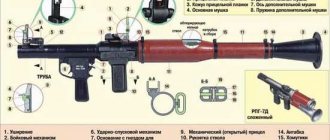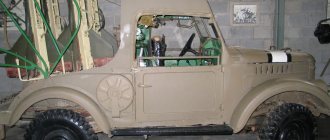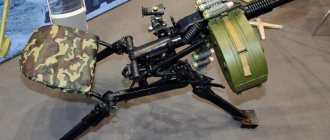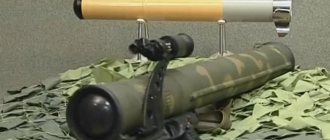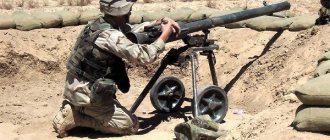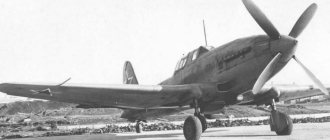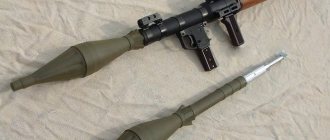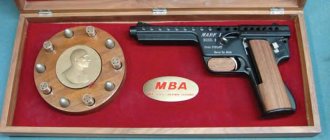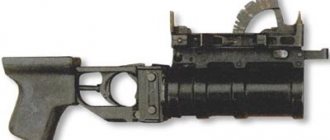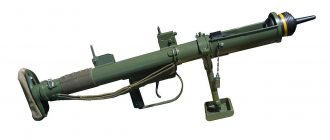A hand-held anti-tank grenade launcher is a type of small arms designed to destroy armored targets with rocket-propelled grenades. Currently, it is the main means of infantry not only for combating enemy armored vehicles, but also for destroying its firing points and other fortifications. The development of RPGs brought infantry units closer in firepower to armored and motorized rifle forces. Unlike a number of other military terms that came into the Russian military lexicon from abroad along with the concepts and phenomena they denote, the phrase “hand-held anti-tank grenade launcher” is purely Russian-language, giving rise to foreign borrowings. For example, the English abbreviation “RPG” (rocket-propelled grenade, rocket-propelled grenade) is a transliterated backronym for “RPG”, adjusted to an already existing expression[1]. It should, however, be taken into account that the expressions “grenade” and “grenade launcher” in NATO countries are used only for recoilless grenade launchers with a reusable barrel, such as the Soviet RPG-7 or the Swedish “Carl Gustav”; all other models have a disposable launcher or a reusable launch device, but a consumable launch tube, are called “rocket launchers”.
| Year | Name | Caliber, mm | Sighting range, m | Armor penetration, mm | Overcoming dynamic protection | Overcoming active defense complexes |
| 1947 | RPG-2 | 40 | 100 | 180 | Not secured | Not secured |
| 1961 (PG-7V) | RPG-7 | 70-105 | 700 (OG-7V, 1998) | 750 (PG-7VR, 1988) | Provided (PG-7VR, 1988) | Not secured |
| 1972 | RPG-18 | 64 | 200 | 150 | Not secured | Not secured |
| 1976 | RPG-16 | 58,3 | 800 | 320 | Not secured | Not secured |
| 1979 | RPG-22 | 73 | 250 | 200 | Not secured | Not secured |
| 1985 | RPG-26 | 72,5 | 250 | 440 | Not secured | Not secured |
| 1989 | RPG-27 | 105 | 150 | 600 | Provided | Not secured |
| 2007 | RPG-28 | 125 | 300 | 900 (for ) | Provided | Not secured |
| 1989 | RPG-29 | 105 | 450 | 650 | Provided | Not secured |
| 2008 | RPG-30 | 105 | 200 | 600 | Provided | Provided |
| 2010+ | RPG-32 | 72,5-105 | 700 | 650/750 (with/without DZ) | Provided | Not secured |
Armor penetration
Almost none of the NATO hand-held anti-tank grenade launchers of the 1970s - 1980s, especially light disposable RPGs of the LAW type in the weight category up to 14 pounds (6.35 kg), could penetrate the frontal armor of contemporary Soviet main tanks equipped with dynamic explosives. protection, therefore in English-speaking countries during this period there was a rejection of the expression “anti-tank” (antitank) in favor of the less specific adjective “anti-armor” (antiarmor), implying use not only and not so much against tanks, but against armored vehicles in general[2]. In this regard, it was easier for German-speaking countries, where the two indicated concepts are denoted by one word (Panzerabwehr).[3] However, as Major General Lawrence Skibbey, Deputy Chief of Staff of the US Army for Research, noted, 2⁄3 of the cases of Vietnamese guerrillas firing at American tanks during the Vietnam War, Syrian infantrymen firing at Israeli tanks during the Fourth Arab-Israeli War were to fire from the flanks or stern, which were always less protected than the frontal part of heavy armored vehicles. A similar indicator was given by the results of military exercises and numerous studies using methods of computer and mathematical modeling of combat operations, therefore the combat effectiveness of hand-held anti-tank grenade launchers should not be judged purely by armor penetration indicators, but statistics of actual cases of shelling/damage of armored vehicles from RPGs should be taken into account[4] .
RPG-29 “Vampire” anti-tank rocket launcher
In the seventies and eighties of the last century, the Soviet defense industry created several types of rocket-propelled anti-tank grenades with different characteristics. This weapon allowed infantry to effectively fight enemy armored vehicles, but had a serious drawback. Rocket-propelled anti-tank grenades were disposable, which had a corresponding impact on their use.
As for hand-held anti-tank rocket launchers, for several decades the newest system of this class in the ground forces was the RPG-7, and the Airborne Forces had the RPG-16 grenade launcher. Over time, these weapons became outdated, which is why the development of new hand-held anti-tank grenade launchers began.
In the mid-eighties, the State Research and Production Enterprise "Basalt", which was engaged in the creation of anti-tank weapons for infantry, began developing the RPG-29 "Vampire"
. Work on the project, named after the bat, was headed by V.S. Tokarev. As part of the new project, it was planned to create an anti-tank grenade launcher capable of hitting modern and advanced tanks of a potential enemy.
The main task of the designers was to create a rocket-propelled grenade that could effectively destroy armored vehicles with dynamic protection systems. Solving this problem made it possible to significantly increase the firepower of rifle units armed with the new grenade launcher.
RPG-29 “Vampire” grenade launcher
is a launching device with sighting devices and fire control devices installed on it. In combat position, the grenade launcher has a length of 1.85 meters. For the convenience of the grenade launcher, the weapon is collapsible. In the stowed position, the Vampire grenade launcher is divided into two blocks, connected using a special coupling.
In addition, for ease of carrying, the sight is removed from the grenade launcher. When disassembled, the RPG-29 grenade launcher has a length of no more than 1 meter. The total weight of the assembled weapon is 11.5 kg; after installing the 1P38 sight, the weapon becomes heavier by about 0.6 kg.
In the middle part of the grenade launcher, on its lower surface, there is a trigger mechanism with a fire control handle and a trigger. On the upper surface of the launcher there are auxiliary sighting devices - a rear sight and a front sight. If necessary, they can be used instead of a standard sight. When disassembling the grenade launcher, the trigger mechanism and sight remain on the “front” half of the grenade launcher. On the “back” there is a folding bipod.
Standard sighting device for the RPG-29 “Vampire”
is an optical sight 1P38. The device with a field of view 13° wide and a magnification of 2.7x allows you to aim the weapon when firing at a distance of up to 500 meters. At the request of the customer, the Vampire hand-held anti-tank grenade launcher can be equipped with a 1PN51-2 night sight. In this case, the weapon receives the supplemented index RPG-29N.
The RPG-29 grenade launcher uses the PG-29V rocket-propelled grenade as ammunition. An interesting fact is that some features of this shot had a serious impact on the appearance of the grenade launcher. For example, the large barrel length (1.85 m) is directly related to the engine used on the grenade.
PG-29V rocket-propelled grenade, 105 mm caliber
was created taking into account the need to hit targets equipped with dynamic protection systems. For this reason, the ammunition carries a tandem cumulative warhead. The leading cumulative charge, located in the front of the grenade, should initiate an explosion of the dynamic protection unit when it hits the target. The latter spends its energy on destroying the cumulative jet of the leading charge. Thus, in front of the main charge of the warhead, the armor of the attacked vehicle remains unprotected. According to available data, the warhead of the PG-29V grenade is capable of penetrating more than 600 mm of homogeneous armor covered with dynamic protection.
Notes
- Rottman, Gordon L.
The Book of Gun Trivia: Essential Firepower Facts, Osprey Publishing, 2013, p. 73, ISBN 978-1-78200-769-2. - Rottman, Gordon L.
The Big Book of Gun Trivia, Osprey Publishing, 2013, p. 121, ISBN 978-1-78200-950-4. - Rottman, Gordon L.
The Rocket Propelled Grenade, Osprey Publishing, 2010, p. 6, ISBN 978-1-84908-153-5. - Testimony of Maj. Gen. Lawrence F. Skibbie, Director, Combat Support Systems Office, Deputy Chief of Staff Research, Development, and Acquisition, United States Army, Department of Defense Appropriations for Fiscal Year 1983, March 4, 1982, pt. 4, p. 2265.
Data for firing from RPG-7 and RPG-7D using the PUS-7 device
Crosswind corrections
| Firing range, m | Side moderate wind (4 m/s) at an angle of 90° to the grenade plane | |||
| Amendments (rounded) | ||||
| in lateral scale divisions amendments | in meters | in tank figures | ||
| during flank movement (tank length 6.9 m) | when moving frontally (tank width 3.6 m) | |||
| 100 | – | – | – | – |
| 200 | – | 0,1 | – | – |
| 300 | – | 0,4 | – | – |
| 400 | – | 0,7 | – | – |
| 500 | – | 1,1 | – | 1/2 |
Note: 1. Corrections for strong winds (8 m/s) should be taken twice as large, and for weak winds (2 m/s) should be taken twice as small as indicated in the table.
2. When the wind blows at an acute angle to the shooting plane, take half the correction as when the wind blows at an angle of 90°.
Leads when shooting at moving targets
| Firing range, m | Bullet flight time, s | Lead (rounded) | |||||
| Flanking target movement (at an angle of 90° to the firing plane) | |||||||
| in divisions of the lateral correction scale | in slipper figures (tank length 6.9 m) | ||||||
| 10 km/h | 15 km/h | 20 km/h | 10 km/h | 15 km/h | 20 km/h | ||
| 100 | 0,35 | 1 | 1,5 | 2 | – | 1/2 | |
| 200 | 0,7 | 1 | 1,5 | 2 | 1/2 | 1/2 | 1/2 |
| 300 | 1,1 | 1 | 1,5 | 2 | 1/2 | 1/2 | 1 |
| 400 | 1,5 | 1 | 1,5 | 2 | 1/2 | 1 | 112 |
| 500 | 1,9 | 1 | 1,5 | 2 | 1 | 1 | 112 |
When the target moves obliquely (at an acute angle to the shooting plane), the lead taken is half as much as when moving flanking.
3. Characteristics of bullet dispersion and the number of rounds required to hit the target
| Range m | Dimensions of median deviations, m | Number of rounds required to hit the target | |||
| Bv | Wb | № 12 | No. 12a | No. 12b | |
| 100 | 0,05 | 0,05 | 1 | 1 | 1 |
| 200 | 0,10 | 0,10 | 1 | 1 | 1 |
| 300 | 0,20 | 0,15 | 1 | 2 | 3 |
| 400 | 0,35 | 0,20 | 2 | 2 | 5 |
| 500 | 0,45 | 0,25 | 3 | 3 | 8 |
Note. When determining cartridge consumption, the average tank speed was assumed to be 20 km/h.
Excess of average bullet trajectories above the aiming line
| Sights | Range, m | |||||||||
| 50 | 100 | 150 | 200 | 250 | 300 | 350 | 400 | 450 | 500 | |
| Exceedances, m | ||||||||||
| 2 | 0,4 | 0,6 | 0,4 | -0,1 | – | – | – | – | – | – |
| 3 | 0,8 | 1,3 | 1,4 | 1,3 | 0,9 | – | – | – | – | |
| 4 | 1,3 | 2,2 | 2,8 | 3,1 | 3,1 | 2,7 | 1,9 | 0,7 | – | – |
| 5 | 1,8 | 3,2 | 4,3 | 5,0 | 5,6 | 5,6 | 5,3 | 4,6 | 3,5 | 1,9 |
Literature
- Smith, Robert
C.
Tank Killers: Infantry Resurgent. // Infantry
. — July-August 1981. — Vol. 71 - No. 4 - ISSN 0019-9532.
| This is a preliminary article about weapons. You can help the project by adding to it. |
| This article lacks links to sources of information. Information must be verifiable, otherwise it may be questioned and deleted. You may edit this article to include links to authoritative sources. This mark was set on March 7, 2012 . |
RPG-75 grenade launcher
| RPG-75 in combat position |
RPG-75 in use
The RPG-75 hand-held anti-tank grenade launcher was designed in the 1970s in Czechoslovakia.
The 68-mm rocket-propelled grenade launcher RPG-75 is a disposable hand-held anti-tank weapon designed to destroy tanks, armored vehicles, fortified enemy targets and use in mechanized units as an additional support weapon.
The RPG-75 grenade launcher launcher consists of two telescopically extendable parts: a pipe and a combustion chamber with a nozzle. The pipe is a shaped product made of duralumin with two reinforcing ribs.
Sighting devices and the trigger, impact and safety mechanisms, as well as stops and latches connecting both parts of the launch device are attached to the trigger device.
| RPG-75 in stowed position 1 - cap; 2 - pipe; 3 — rubber band; 4 — sight; 5 fuse; b - cotter pin; 7 — trigger rod with a protrusion; 8 — plate with drummer; 9 - nozzle. |
| Grenade launcher caliber, mm | 68 |
| Grenade launcher weight, kg | 3.2 |
| Weight of starting device, kg | 2.2 |
| Grenade launcher length, mm (stowed / firing position) | 630 / 890 |
| Maximum firing range, m | 300 |
| Armor penetration, mm | 300 |
| Self-liquidator operating time, s | 3-6 |
The combustion chamber is made of steel and ends with a nozzle. Inside it there is an igniting composition and a propellant charge, attached using a special grid. The igniter capsule is placed in a socket located in the wall of the combustion chamber in such a way that it can be pierced by the firing pin only after the starting device is unfolded. Powder gases exit the combustion chamber through a small hole forward, driving the projectile, and also backward through the nozzle, ensuring a balance of forces during the shot. A rubber shock absorber is placed on the nozzle. The role of the front shock absorber is performed by a rubber cap worn in the stowed position on the muzzle section of the starting device.
| RPG-Nh-75 with grenade (PrNh) |
RPG-Nh-75 in traveling and combat positions
The RPG-75 trigger mechanism consists of a trigger rod with a protrusion that functions as a trigger and a firing pin mounted on a rotating plate. Before the shot is fired, the firing pin is constantly in the cocked position, but is blocked by the trigger rod. After pressing the protrusion, the rod moves forward and releases the plate with the striker. The safety function is performed by a spring-loaded plate that blocks the movement of the trigger rod. The rod can move only after additional force to press the plate against the tube of the starting device. In addition, the trigger mechanism is locked using a cotter pin (with a factory seal).
| RPG-75-TB with thermobaric grenade |
instructions for use of RPG-75
The sighting devices of the RPG-75 grenade launcher consist of a sight and a front sight. The sight is hinged on the launcher tube. It has a rotating shield with three visors corresponding to different ambient temperatures. In the stowed position, the sight is adjacent to the trigger device and is held in place by a rubber band. A rotating front sight in the form of a plate (with an aiming grid and a slot that makes it easier to determine the distance to the target) is installed together with the cover in such a way that, in the stowed position, overcoming the resistance of its spring, it closes the muzzle of the starting device. It is held in this position by a latch. The sight reticle consists of one vertical and four horizontal wires, the position of which corresponds to shooting distances of 100, 200, 250 and 300 m. One of them has two marks for introducing correction for lateral movement of the target (at a speed of 25 km/h at a distance of approximately 225 m). The next gaps (steps) have the dimensions of the side silhouette of the tank, visible from a distance of 200, 250 and 300 m.
In the factory, a projectile is installed inside the launch device. It consists of a ballistic tip, housing, shaped charge and bottom fuze. The projectile is attached with two screws to the protrusions of the front wall of the combustion chamber. The screws are cut off after reaching the appropriate pressure in the chamber. The shaped charge consists of phlegmatized hexogen. The fuse is equipped with a self-liquidator, causing the projectile to explode if it misses the target. The aerodynamic stabilization of the projectile without the use of fins, used during its flight along the trajectory, deserves attention. Stabilization is achieved through appropriate mass distribution as well as the shape of the projectile. They make it possible to effectively use the aerodynamic factor.
To fire a shot from the RPG-75, you need to remove the rubber cap from the muzzle of the pipe, break the seal, turn the nozzle to the left until it stops (45°), pull it with the combustion chamber out of the launcher tube and turn it to the right to block them, raise the sights and enter the correction to the temperature, remove the cotter pin, take a shooting stance, press the safety with your index finger and move the trigger rod forward with the thumb of your other hand.
RPG-Cv-75 training model The
grenade launcher maintenance instructions are pasted on the launcher.
Based on the RPG-75 grenade launcher with a cumulative grenade, a number of combat and training modifications of this weapon were developed:
— RPG-Nh-75 — with a grenade (PrNh); — RPG-75-TB — with a thermobaric grenade; — RPG-Cv-75 — training model (for shooting at shields); — RPG-Šk-75 — educational (school) grenade launcher.
After the collapse of Czechoslovakia and its withdrawal from the Warsaw Pact, the production of RPG-75 grenade launchers was established at the MOEX plant - Vlarske Stroijny in Slavicin (Czech Republic).
| RPG-Šk-75 training version |
Anti-tank grenade launcher Panzerfaust 3 (Germany)
The name "Panzerfaust" has been assigned to RPGs in Germany since World War II. At the end of the 70s, the Germans decided to return to the idea of a disposable RPG with an over-caliber grenade, but capable of firing from confined spaces. The corresponding work was carried out from 1978 to 1985. The result was the Panzerfaust 3 ( Pzf.3 ) RPG, which was adopted to replace the Panzerfaust-44A1. The Panzerfaust 3 RPG consists of a barrel with a cumulative active-reactive grenade and a “counter-mass”, a removable trigger mechanism with controls and an optical sight. The grenade launcher's launch tube is disposable, made of fiberglass-reinforced plastic and has an aluminum liner. It houses a grenade, a propellant charge with an igniter, and a countermass. The trigger mechanism and sight, which are used repeatedly, are attached to the launch tube.
The trigger mechanism is equipped with a safety lever on the left side of the body. On the body of the firing mechanism, a folding front holding handle, a pistol grip and a shoulder rest are hinged (i.e., the control of the Panzerfaust 3 is almost no different from the same “Lanze”), and the optical sight bracket is also attached to the same body on the left side. The optical sight reticle allows you to determine the approximate distance to the target and enter lead angles. There is a reticle illumination device. To protect the grenade launcher from burns, a barrel casing is used, a barrel handle is used to carry the barrel in a pack, and a shoulder strap is used to carry the assembled RPG. After the shot, the trigger mechanism and optical sight are separated and placed on another equipped barrel.
The Panzerfaust 3 grenade launcher can be used for firing from enclosed spaces, provided that the muzzle opening of the launch tube is located outside the room. Otherwise, the shooter may suffer from excess gas pressure. After leaving the launch tube, the countermass breaks up into small parts.
The main feature of Panzerfaust 3 is the way the grenade is fired. The powder gases of the starting charge, pushing the grenade towards the muzzle of the barrel, simultaneously push towards the breech a “counter-mass” equal to the mass of the grenade and made up of many light plastic flakes that quickly lose speed in the air. The countermass falls to the ground within 10 m from the breech end of the barrel. This significantly reduces the danger zone behind the RPG and allows firing from enclosed spaces without danger to the grenade launcher and other unit soldiers. The starting charge is initiated by the primer.
To reduce the sound level of a shot, as well as smoke and flame, the developers limited the initial speed of the grenade to 165 m/s, and to increase the target range and reduce the grenade’s flight time to the required level, they equipped the grenade with a powder jet engine, which turns on at a distance of about 10 m from the grenade launcher. The grenade has a piezoelectric fuse; the rod of the head ensures detonation at the optimal distance from the armored barrier and, in some respects, neutralizes this type of “anti-cumulative›› protection such as fabric screens. The grenade's flight time at a distance of 300 m is 1.55 s. The grenade is stabilized in flight by folding planes. To increase the cumulative effect, the warhead is equipped with a retractable core.
In 1987, Panzerfaust 3 entered service with the Bundeswehr and attracted interest from other armies. Its effectiveness is beyond doubt among experts, but the disadvantages of RPGs include their relatively large weight. Panzerfaust 3 can also be used in anti-aircraft mines.
Tactical and technical characteristics of Panzerfaust 3 Grenade launcher caliber - 60 mm Grenade caliber - 110 mm Grenade launcher length - 1200 mm Grenade launcher weight in firing position - 12 kg Launcher weight with optical sight - 1.75 kg Grenade weight - 3.8 kg Initial grenade speed — 165 m/s Maximum grenade speed — 250 m/s Effective firing range: — 300 m against moving targets — up to 500 m against stationary targets Armor penetration — 700 mm of homogeneous steel armor Crew — 1 person
Performance characteristics of LNG-9 Spear
Adopted: 1962 Designer: V. I. Silin, A. T. Alekseev
Caliber SPG-9
— 73 mm
Weight of LNG-9
— 47.6 kg
Dimensions of LNG-9
— Length, mm: 2110 — Barrel length, mm: 670 — Width, mm: 1055 (in firing position) — Height, mm: 820
Rate of fire SPG-9
— 6 shots/min
SPG-9 projectile speed
— 435 m/s at the beginning, up to 700 m/s after acceleration (PG-9); 316 (OG-9)
Sighting range of SPG-9
— 800 meters
Maximum range, m: 1300, separate firing with a fragmentation grenade - 4500 Crew, people: 4 Carriage: tripod Elevation angle: +7° PG-9V, +25° OG-9V / -3° Rotation angle: +-15° Type of ammunition supply : manual loading Sight: optical PGO-9 with 4.2x magnification; night PGN-9 infrared
SPG-9 Spear - video
The SPG-9 Spear fires fin-stabilized projectiles with a shaped charge or high-explosive warhead, similar to those used in the 73 mm low-pressure 2A28 Grom cannon, which is installed in the BMP-1
The projectile is launched from a cannon with a small charge, which gives it an initial speed of 250 to 400 meters per second. When fired, the gases generated from the combustion of the powder charge eject the grenade from the barrel, and some of the powder gases are diverted back through the nozzle. In this case, a reactive force is formed, which balances the recoil force. When the projectile is approximately 20 meters from the launcher, the rocket engine is turned on. For the PG-9 projectile, the rocket engine accelerates it to a speed of 700 meters per second before the fuel burns.
The version for use with airborne troops is called the SPG-9D and has a tripod with wheels for manual transportation.
SPG-9 “Spear” consists of a barrel with a bolt, a tripod (a machine with wheels for the landing version), an electric mechanism for firing a shot, and a sight. The barrel has a handle for rolling the weapon, a safety lock that protects the gunner from burns (from a heated barrel, a mechanism for removing the cartridge case after a shot, an electric trigger mechanism. A nozzle-shaped bolt with a mechanism for locking and unlocking the barrel is attached to the barrel. The tripod frame has the ability to adjust the position of the legs , due to which the height of the firing line can vary from 390 to 700 mm.
For direct fire, the PGO-9 optical sight with fourfold magnification is used. To launch a projectile, an electric mechanism is used, the generator of which, together with the trigger mechanism and fuse, is located in the frame. This mechanism includes a contact and blocking device, which does not allow firing if the bolt is not completely closed.
The PG-9V shot consists of a cumulative grenade and a starting powder charge. The PG-9 has a caliber warhead with a head-mounted piezoelectric fuse, a jet engine with a six-blade stabilizer and two tracers. The starting charge consists of a metal charger (perforated tube with a diaphragm), a sample of nitroglycerin powder in a percale cap, an ignition charge made of DRP with an electric igniter, and a boost unit. The PG-9V shot has a convenient quick-release unit for connecting the powder charge to the grenade. When launched, the grenade receives an initial speed of up to 435 m/s, and the jet engine accelerates it to a maximum speed of 700 m/s. High speed reduces the grenade's flight time, which makes it possible to reduce the amount of corrections for side winds and fire at short ranges without introducing corrections (direct shot).
In the seventies, the PG-7V shot was modernized. The new shot, called PG-7VS, received greater armor penetration - 400mm. Later, to increase the fire capabilities of motorized rifle units in the fight against enemy personnel, a shot with a fragmentation grenade - 0G-9V - was developed. The new shot has only a starting powder charge, without a jet engine. To ensure firing of the new grenade, the grenade launcher was also modernized.
The grenade launcher is loaded from the breech of the barrel with the bolt open. After closing the bolt, the electrical circuit of the grenade launcher is closed and ready to fire. To fire a shot, you must cock the trigger by turning its handle down. Then, by pressing the trigger, the generator inductor is activated. The electric current generated by the generator is supplied to the contact device and then to the electric igniters of the starting powder charge, which ignite the igniter and the starting powder charge.
The gases act on the grenade, at the same time the shank is disconnected from it, and the grenade begins to move along the barrel of the grenade launcher; Some of the gases break through inclined tangential holes in the outer part of the nozzle and give the grenade a rotational movement. With a further increase in gas pressure, the disks of the forcing unit are destroyed (pressed through) and gases begin to flow through the grenade launcher bolt nozzle. After the grenade leaves the barrel, under the influence of the oncoming air flow and centrifugal forces, the stabilizer blades open, and at a distance of 15-20 m from the barrel cut, after the pyromoderator is activated, the combustion of the jet engine gunpowder begins, the grenade’s flight speed increases to maximum. After the shot, it is necessary to open the bolt, and a diaphragm with a tube on which the powder charge was placed extends from the breech of the barrel.
The SPG-9 crew consists of four people: commander, gunner, loader and carrier. This crew is capable of carrying a grenade launcher in a disassembled (stowed) position over long distances, as well as moving the SPG-9 in a combat position when changing firing positions.
The grenade launcher was modernized and produced in several modifications:
- landing grenade launcher SPG-9D (GRAU index - 6G7);
- modernized grenade launcher SPG-9M (GRAU index - 6G13);
- modernized landing grenade launcher SPG-9DM (GRAU index - 6G14);
- modifications with a night sight PGN-9 (GRAU index - 1PN52) - SPG-9N, SPG-9DN, SPG-9MN and SPG-9DMN.
The BMP-1/1P, as well as the BMD-1, is equipped with the 2A28 “Grom” smoothbore gun, which is an SPG-9 modified for installation in combat vehicles.
The following ammunition has been developed for the grenade launcher:
- PG-9V shot (GRAU index - 7P3) with a PG-9 anti-tank grenade,
- OG-9V shot (GRAU index - 7P4) with OG-9 fragmentation grenade,
- OG-9VM shot (GRAU index - 7P4M) with OG-9M fragmentation grenade,
- OG-9VM1 shot (GRAU index - 7P4M1) with OG-9M1 fragmentation grenade,
- PG-9VS shot (GRAU index - 7P14) with a PG-9S anti-tank grenade,
- PG-9VS1 shot (GRAU index - 7P20) with a PG-9S1 anti-tank grenade.
